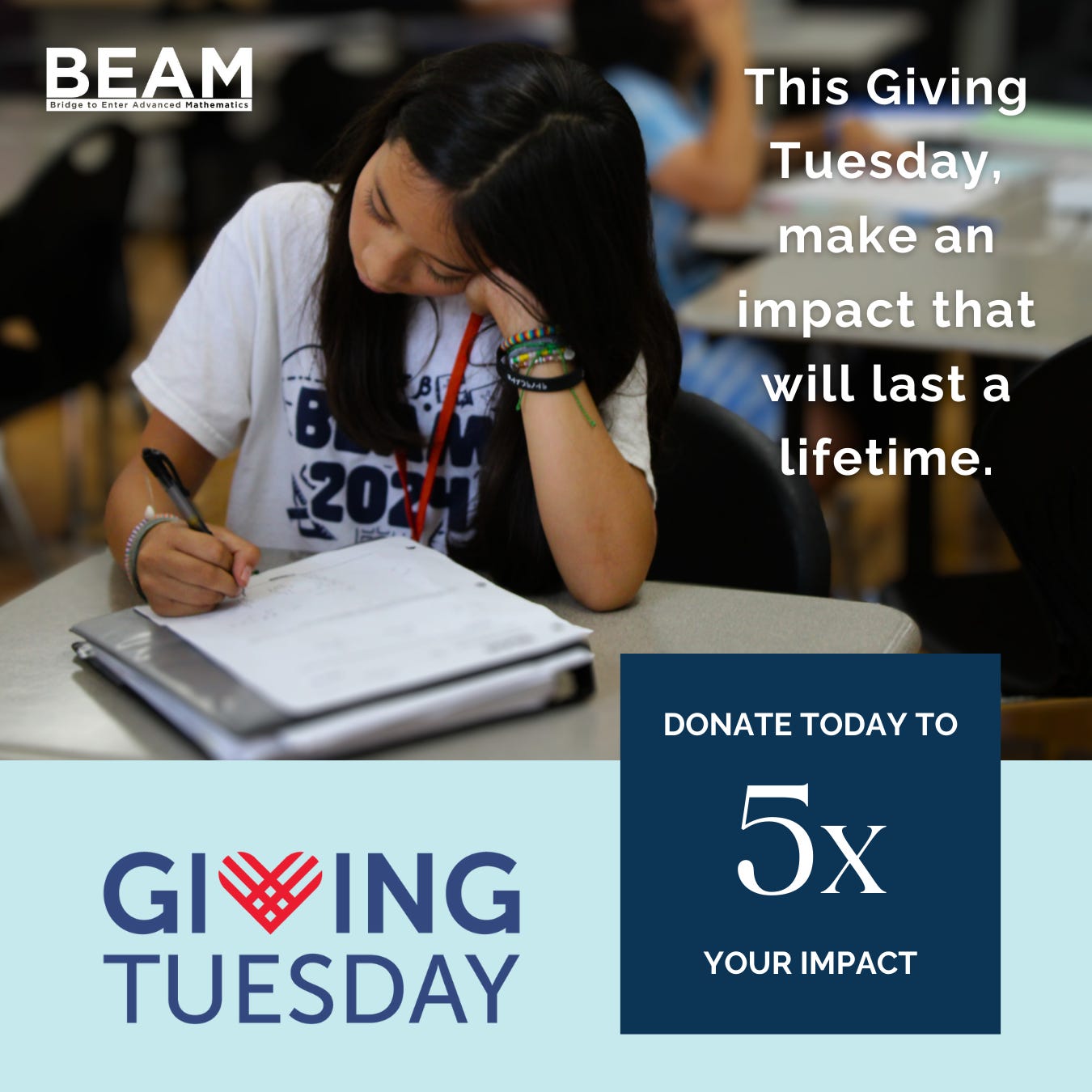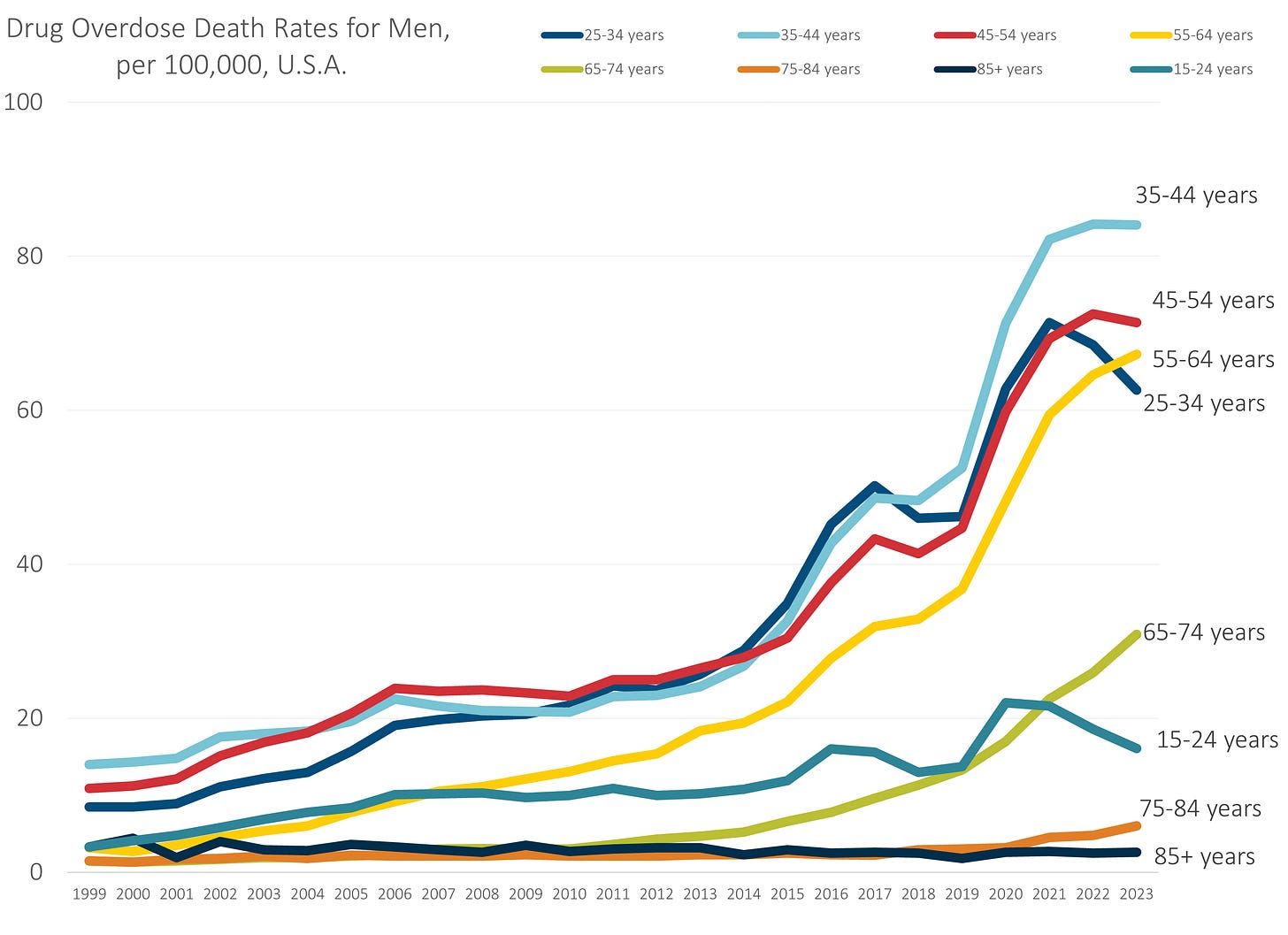Today I’ll be closing out my Movember fundraiser, but… as it’s Giving Tuesday, I want to highlight one of my other causes: math education, especially for underserved students who have prospects to achieve at high levels, if only they had the resources.
BEAM: Bridge to Enter Advanced Mathematics
As with Movember, I have a personal connection with BEAM.
BEAM was founded by Dan Zaharapol, who I first knew as a student and then as a colleague at Canada/USA Mathcamp.
Daniel Zaharopol
BEAM Founder and AOPSI Chief Executive Officer
Dan founded BEAM with a unique vision: to create pathways for underserved students to achieve their STEM dreams. He has shepherded BEAM through a period of extraordinary growth — from serving 17 students to more than 1,000 students annually, and has built the organization into a valuable contributor to the national conversation around equity in STEM. In addition to his work at BEAM, Dan leads the board of Canada/USA Mathcamp and is on the board of the New York Math Circle. An award-winning teacher, Dan is himself a product of numerous enrichment math programs. He received an undergraduate degree in math from MIT and master’s degrees in both mathematics and teaching mathematics from the University of Illinois.
In an early year of BEAM, I was able to buy math books for all the students, so they could have their own copies they could take home. If I remember correctly, I bought them 2 books each, one was a “serious” math book on proofs, and the other a “frivolous” one, though I considered the frivolous one more important.
I especially wanted them to have copies of Flatland/Sphereland, which captured my imagination of what math could be, beyond the "boring” regular math in school. But also, the type of math seen in Flatland/Sphereland is more like what one encounters in “real” math — i.e., academic math in graduate school and beyond. You rarely encounter this in K-12.
The mission of BEAM is “For underrepresented students to thrive in STEM”, and both Dan and I know that it requires a lot more work than your standard K-12 can give students. To really thrive in top levels in STEM fields requires more opportunities than many students get, especially those in underserved communities.
BEAM has grown to a scale that I wouldn’t be able to afford to buy every student a book now, even if I just stuck to the NYC area:
Our New York students come from across the city.
Students Served: 4,000+ since 2011
By Gender: 48% female, 48% male, 4% nonbinary/gender fluid
By Race/Ethnicity: 81% come from minoritized racial or ethnic groups underrepresented in STEM (Black/African American, Latinx/Hispanic, Indigenous)
By background: More than 74% will be the first in their families to graduate from college
Median family income: $37,000 (median family size is 4)
I’ve already made my donation, and gotten the 5x match. Please donate!
Movember 2024: In Memory of Stu
Here is my last donation plea for Movember in 2024:
Here are the places you can donate to the Movember Foundation, which supports men’s health, specifically focusing on prostate cancer, testicular cancer, and men’s mental health:
Mary Pat Campbell’s MoSpace – a place to donate at Movember itself
My Movember Facebook fundraiser – my officially linked fundraiser, if this works better for you
And here’s a QR code if that works better for you:
The Movember 2024 posts, in no particular order:
Movember 2024: Heart Disease, Cardiac Arrest, Winter Activities, and Men
Podcast: Movember 2024: My Motivations and the Movember Movement
Movember 2024: Prostate Cancer Mortality Trend Update, 1968-2023
I did choose to put the drug overdose post last. As noted in that post, drug OD deaths trended downward in 2023:
But it was only in comparison to 2022.
Here is a recent story from the Wall Street Journal.
1 Dec 2024: A Generation of Drug-Addiction Survivors Is Entering Old Age
America’s drug crisis has many survivors. Jerry Schlesinger, 72, is among the longest tenured.
He tried heroin at 15. Today, he has been sober for two years. In between, decades of illicit drug use wrecked his lungs and teeth and compromised his liver. America spent millions of dollars imprisoning, housing and treating him before he stopped using.
“You’re not done until you’re done,” Schlesinger said.
His is a living history of a drug crisis that has left millions of people in poor health and searching for purpose. The most senior are entering old age. Their struggles show how the damage wrought by addiction will linger long after the death toll drops.
Drug-overdose deaths have fallen below 100,000 annually for the first time since 2021, U.S. figures show. Some of the 15% drop in annual deaths could be because hardened users are outlasting novices who succumbed in great numbers as fentanyl infiltrated the illicit drug supply.
The WSJ article didn’t have the graph, but I do:
The highest death rates are for men aged 35-44 years old.
You can see that the death rates for those aged 65-74 have been climbing (this is just males — their rates are much higher than females, as seen above on an age-adjusted basis.)
Back to the article:
Still, more than two million people over 65 are addicted to drugs, federal figures show—a more than 10-fold increase in a decade. About three-fourths of people addicted to drugs recover, a federal study showed in 2023.
….
During the early 2000s, when much of the street supply was prescription opioids, he paid a pain doctor to prescribe pills he sold to get heroin. Then dealers started swapping heroin for fentanyl, a synthetic opioid that is far more potent but shorter-acting. Schlesinger said he refused to sell it, when he could spot it in his supply.
….
Schlesinger enrolled in Medicare to cover treatment related to his recovery and old injuries. His shoulder, neck and back were injured when he was arrested in a heroin bust in 2008, he said, and his ribs were shattered in 2012 when a roommate body-slammed him at a sober-living home.
In 2022, Schlesinger and his longtime girlfriend were using drugs when she overdosed. He gave her three doses of the overdose-reversal drug naloxone and performed CPR for 30 minutes before she came to.
He stopped using drugs. She didn’t. When he entered treatment at a recovery home affiliated with Healthright 360, she burned all his clothes in the parking lot of their trailer park.
“I started chasing sobriety like I was chasing heroin. It’s the only way I know I can keep it,” he said.
Part of the drop-off in drug OD deaths from the 55-64 age group to 65-74 age group may be due to Medicare eligibility at age 65.
But it may also be due to illicit drug users tending to die younger.
It is difficult to kick once hooked, and I have a lot of sympathy — I know people who have gotten addicted in many ways. Some are from chronic pain situations. Some from social situations. Some from untreated mental/emotional illnesses.
I do hope the downward trend in drug OD death rates continues, but I don’t know. It’s a difficult problem.
Movember is one of the groups searching for solutions by addressing men’s mental health problems.









